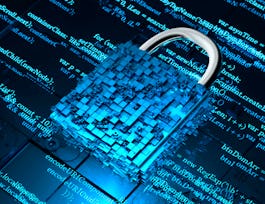In this MOOC, we will learn the basic cyber security concepts, how to identify vulnerabilities/threat in a network system. We will apply CIA basic security services in the triage of recent cyberattack incidents, such as OPM data breach. We will learn the risk management framework for analyzing the risks in a network system, and apply the basic security design principles to protect the data and secure computer systems. We will examine the trustworthiness of programs and data installed in our systems and show the proper way to verify their integrity and authenticity. We will apply principle of least privileges for controlling the shared access given to different groups of users and system processes. On Amazon Cloud instances, we will use GnuPG software to generate public/private key pair for signing/verifying documents and open source software, and for encrypting documents. We will learn how to publish software, the related signature and release key on web server and publish public key to PGP key server for others to retrieve. We will learn Public Key Infrastructure (PKI) and Linux utility to serve as a CA for an organization, learn how to sign certificate request for clients or servers in secure email and web applications.



Design and Analyze Secure Networked Systems
This course is part of Fundamentals of Computer Network Security Specialization

Instructor: Edward Chow
Sponsored by Mojatu Foundation
41,196 already enrolled
(212 reviews)
Skills you'll gain
Details to know

Add to your LinkedIn profile
4 assignments
See how employees at top companies are mastering in-demand skills

Build your subject-matter expertise
- Learn new concepts from industry experts
- Gain a foundational understanding of a subject or tool
- Develop job-relevant skills with hands-on projects
- Earn a shareable career certificate


Earn a career certificate
Add this credential to your LinkedIn profile, resume, or CV
Share it on social media and in your performance review

There are 4 modules in this course
In this module, we will introduce the basic cyber security concepts, enable you to identity root causes of vulnerabilities in a network system and distinguish them from the threats from both inside and outside. We will analyze the enabling factors of recent cyber attack incidences and discuss the basic security services for their defense and triage. We will introduce the risk management framework for analyzing the risks in a network system, and apply the basic security design principles to protect the data and secure the computer systems. Trust is critical and in the center of any secure systems. We will examine the source and authenticity of the programs and data installed in systems we used daily and show the proper way to check their integrity, and verify their authenticity.
What's included
6 videos6 readings1 assignment1 peer review2 discussion prompts
In this module we apply principle of least privileges for controlling the proper access given to users and system process. We will demonstrate such an access control by using an example of project document access control using the Unix file access mechanism. We use OPM data breach example to show the impact and the need for principle of adequate data protection. Trust is critical and in the center of any secure systems. We will examine the source and authenticity of the programs and data installed in systems we used daily and show the proper way to check their integrity, and verify their authenticity.
What's included
3 videos3 readings1 assignment1 peer review
In this module, we introduce GPG software tool for generating public key private key pair for signing/verifying the documents and to encrypt documents, and publish our public key on our web server and PGP key server for others to retrieve. We will use GnuPG software tool to verify the common opensource software packages such as apache and putty. We will also learn how to sign software and the proper way to list the software package, their pgp signature, and our signing public key on a web site.
What's included
3 videos3 readings1 assignment1 peer review
In this module, we will learn the Public Key Infrastructure (PKI), how CA operates, and the certificates signing and verification process. We will utilize the utility command in a Linux system to serve as a CA for an organization, learn how to sign certificate request for clients or servers both secure email or secure web access purpose. We will earn how to generate server certificate requests as a webmaster, send them to CA for signing and install the signed certificates in Apache web server for secure web access. We will also set up apache web server for requiring clients to present their client certificates for mutual authentication. We will also guide you to set client certificate on browser for mutual authentication and on a mail client for signing and encrypting emails.
What's included
6 videos5 readings1 assignment1 peer review
Instructor

Offered by
Why people choose Coursera for their career




Learner reviews
212 reviews
- 5 stars
51.41%
- 4 stars
19.33%
- 3 stars
7.07%
- 2 stars
6.60%
- 1 star
15.56%
Showing 3 of 212
Reviewed on Jun 5, 2020
The documentation was a bit outdated for some stuff, but overall a good course. I definitely learned a lot as a total beginner.
Reviewed on Jan 9, 2021
This is a very intuitive and flexible course upon deadlines. The instructor has control over the course hence making understanding very simple
Reviewed on Aug 13, 2019
It is very good to learn basic security for the computers and Networks. Up to week 4 I learn only computer security.
Recommended if you're interested in Computer Science

LearnQuest

Stanford University

Open new doors with Coursera Plus
Unlimited access to 10,000+ world-class courses, hands-on projects, and job-ready certificate programs - all included in your subscription
Advance your career with an online degree
Earn a degree from world-class universities - 100% online
Join over 3,400 global companies that choose Coursera for Business
Upskill your employees to excel in the digital economy




